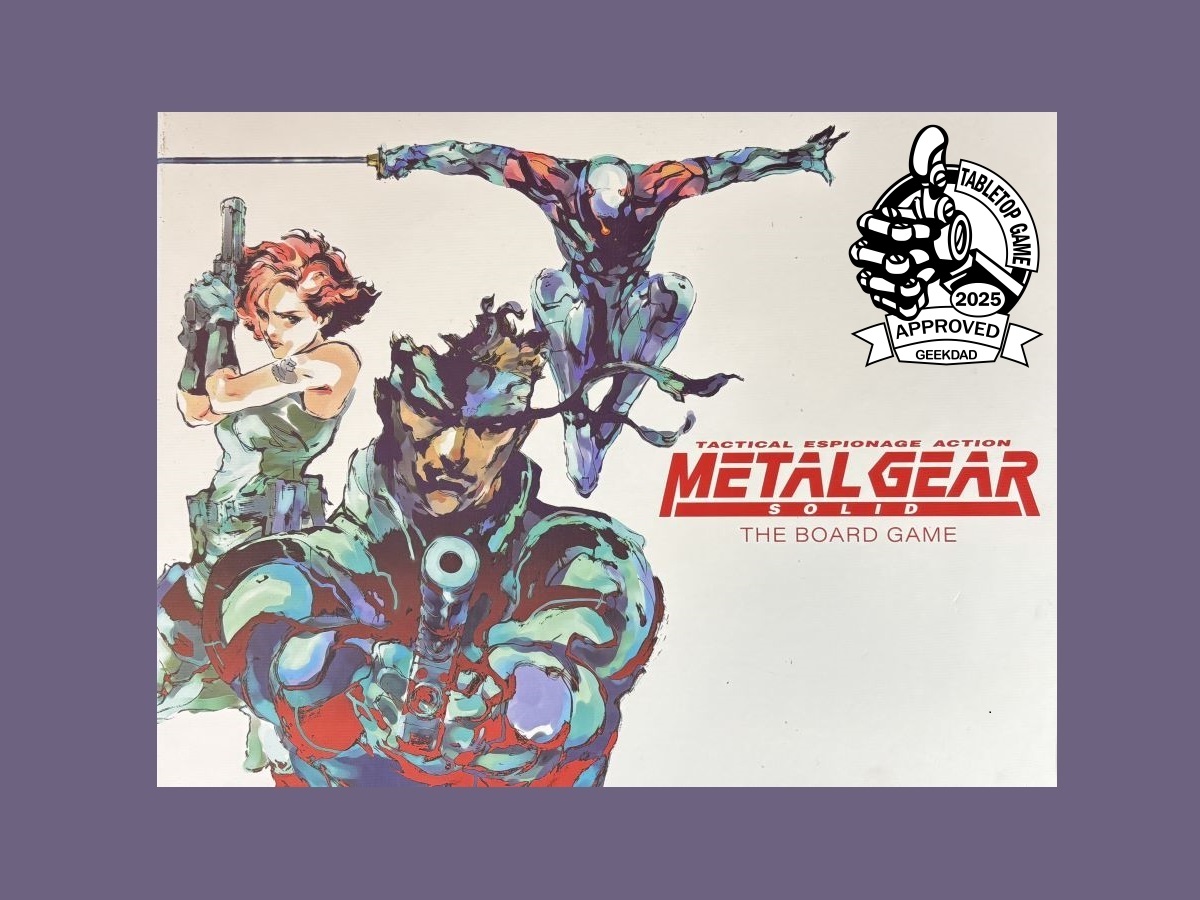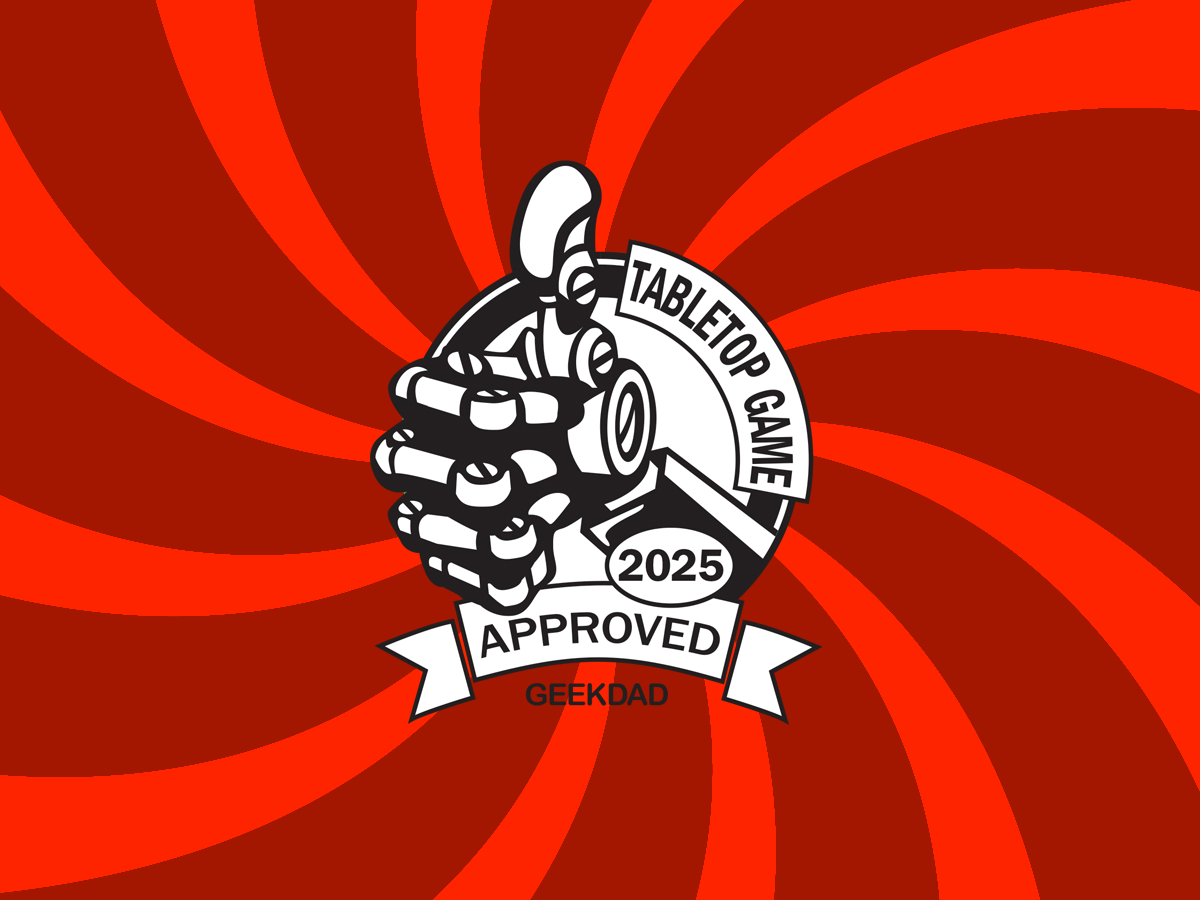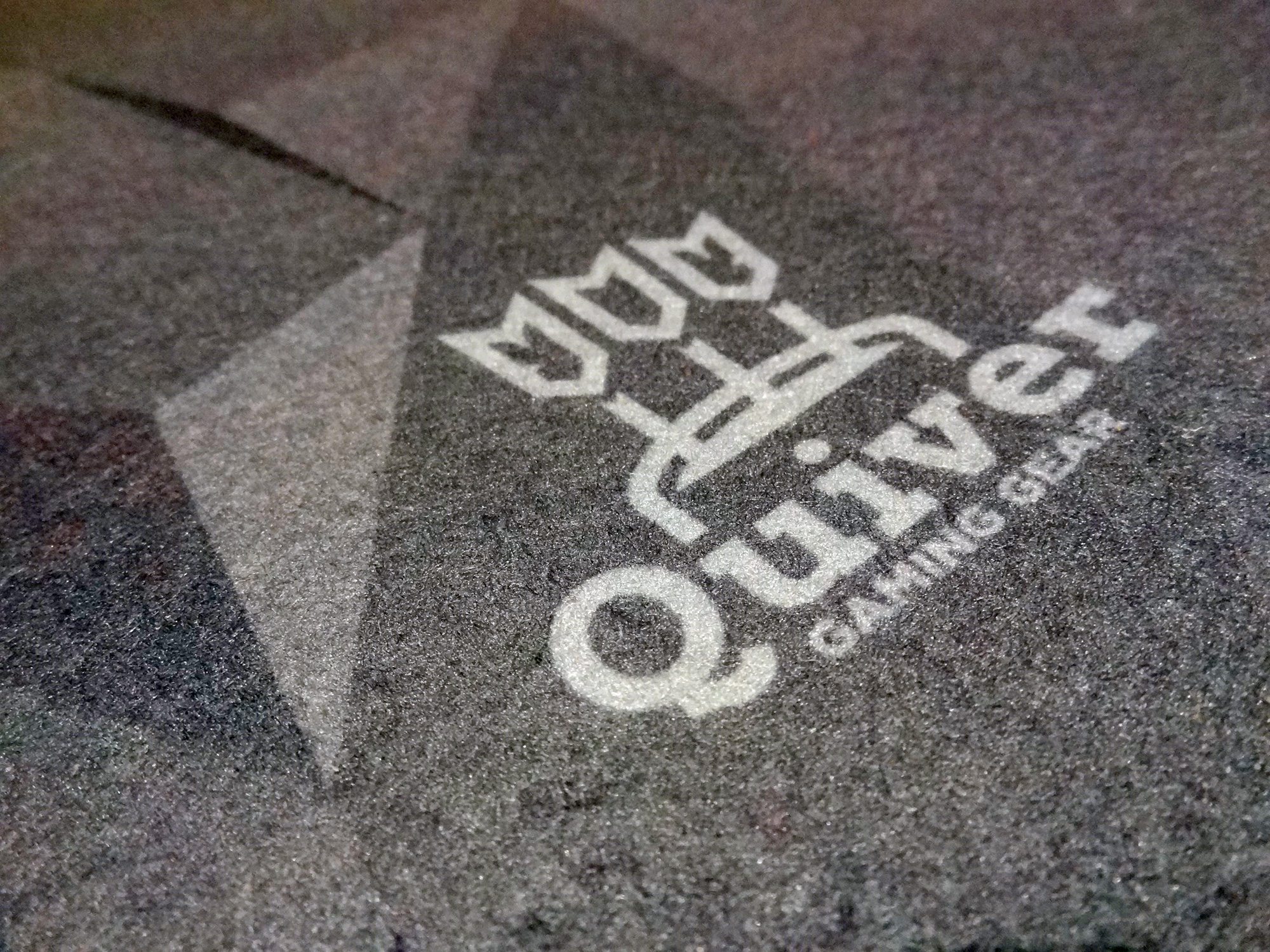In the summer of 1988, I discovered my favorite game for the Nintendo NES. This stealthy game let me take on the role of a secret operative as I infiltrated a secret base, used silenced weapons and gadgets, and uncovered a plot that could devastate the world I was hooked on Metal Gear right from the start. Unlike many other games, I played this one all the way to the end and beat it. Metal Gear left such an impression on me that 37 years later, as soon as I heard there was a board game based on the video game, I could not wait to get my hands on a copy of Metal Gear Solid: The Board Game.
What Is Metal Gear Solid: The Board Game?
Metal Gear Solid: The Board Game is a cooperative stealth miniatures game for 1-4 players, ages 14 and up, and takes about 60-90 minutes to play. It’s currently available from your local game store as well as online retailers such as Amazon with a suggested retail price of $109.99 for a copy of the game.
Metal Gear Solid: The Board Game was designed by Emerson Matsuuchi and published by CMON, with illustrations by Jose David Lanza Cebrian, Marco Checchetto, Fabio de Castro, Max Duarte, Júlia Ferrari, Mathieu Harlaut, Saeed Jalabi, Sebastian Koziner, Kenneth Loh, Henning Ludvigsen, Aragorn Marks, and Francesco Orrù.
Metal Gear Solid: The Board Game Components
Here is what you get in the box:
- 5 Character figures
- 5 Boss figures
- 12 Guard figures
- 2 Carboard box figures
- 16 Double-sided tiles
- 4 Player dashboards
- 6 Boss dashboards
- 1 Guard dashboard
- 171 Cards
- 225 Tokens
- 1 Boss Tracker
- 1 Rulebook
- 1 Campaign book
- 1 VR Missions book
- 1 Codec book
- 15 Dice

Each character has their own figure. Players can choose to play as Solid Snake, Meryl, Otacon, or Gray Fox. Meryl has a second figure used when she is disguised as a guard.
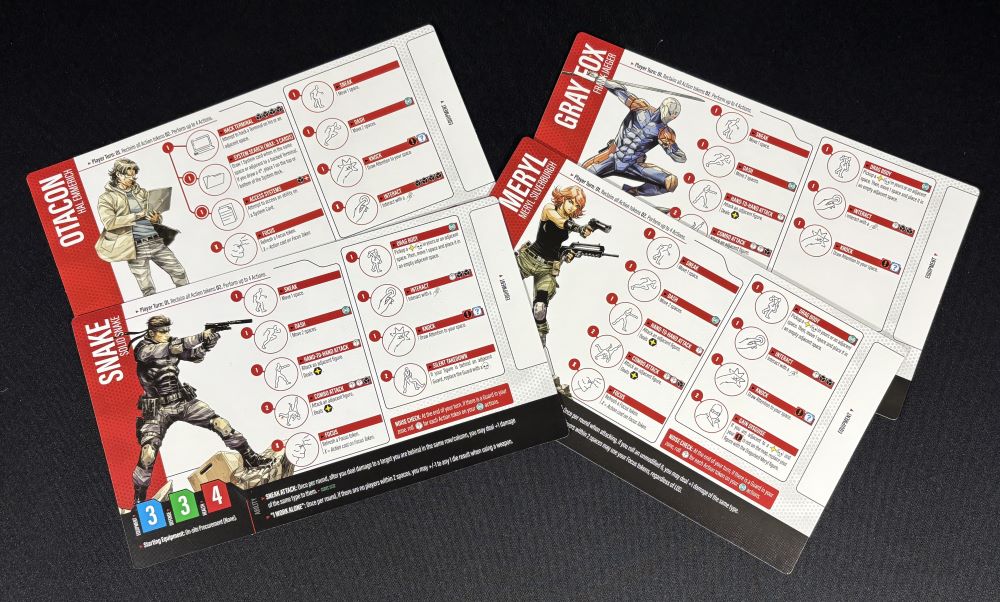
There is a player dashboard for each of the four characters. This contain all of the actions a player can take as well as their stats for health an defense as well as the amount of equipment they can take with them. Be sure to pay attention to their unique abilities listed at the bottom of the dashboard. Some of these allow you to inflict additional damage against enemies. The backside of the dashboard contains a biography of the character.
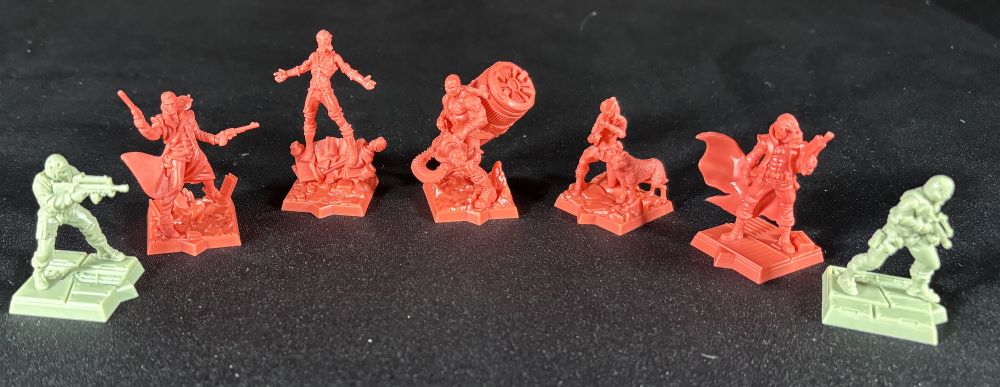
Enemies are represented by figures as well. There are five reddish boss figures and 12 green guard figures in two different sculpts. All guards act the same despite the two sculpts.
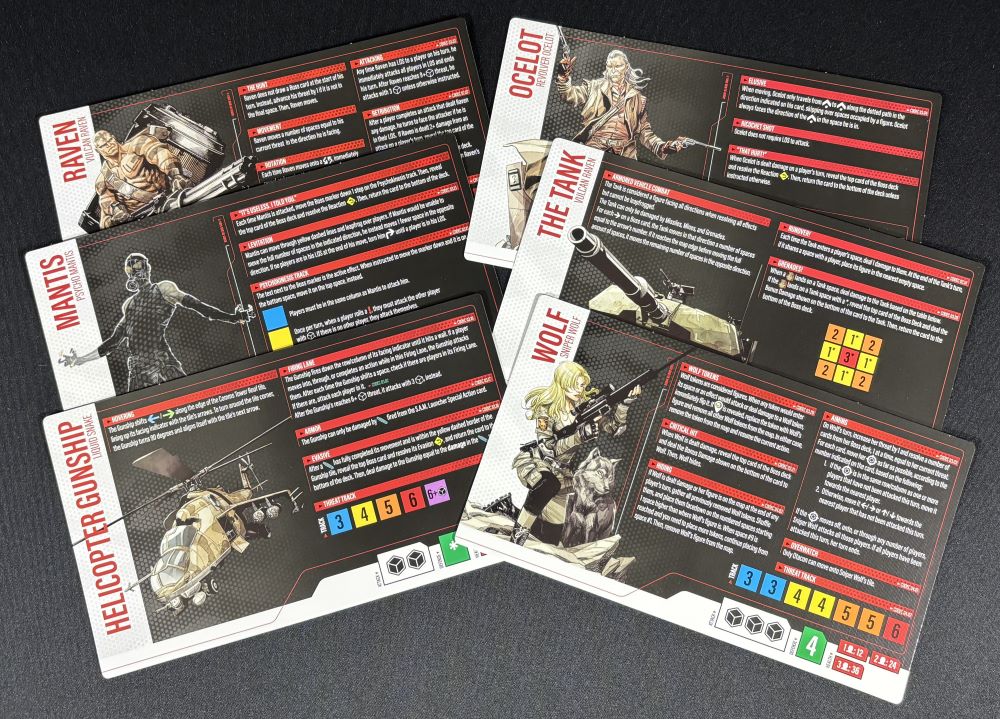
Each boss has their own dashboard similar to the players’ dashboards. These list the stats for the boss as well as details on how they act during a boss stage. Some have trackers on them as well. The green side of the boss dashboard is used for the VR missions.
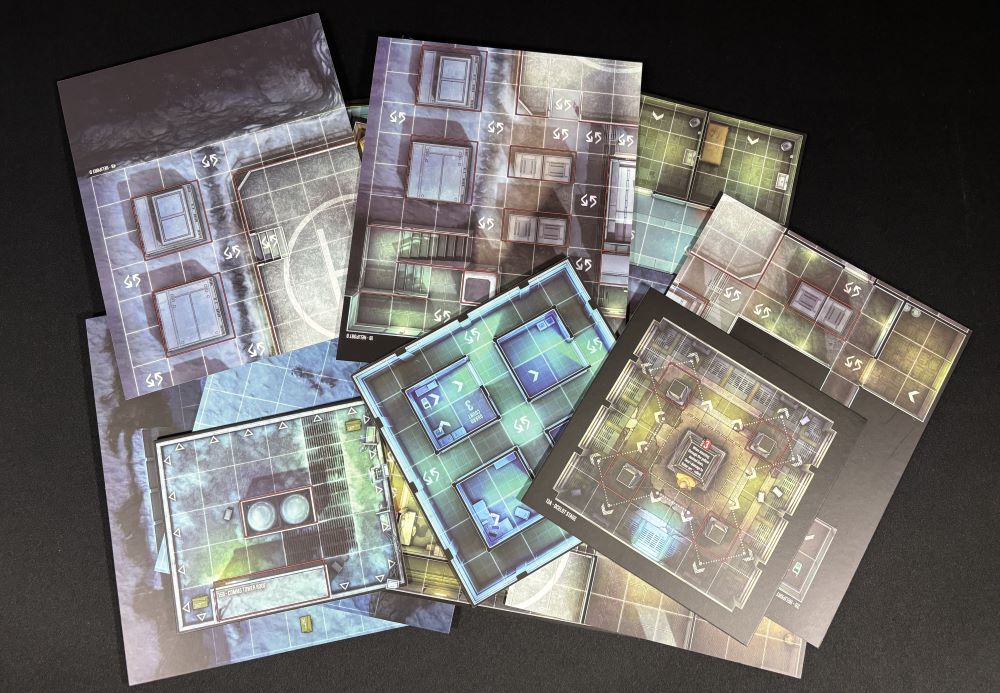
The map tiles are used to create the many different maps for the various stages and missions. They are all full-color and double-sided. There are also some smaller tiles used for boss battles or to represent elevators and elevator shafts of small rooms attached to the large tiles.
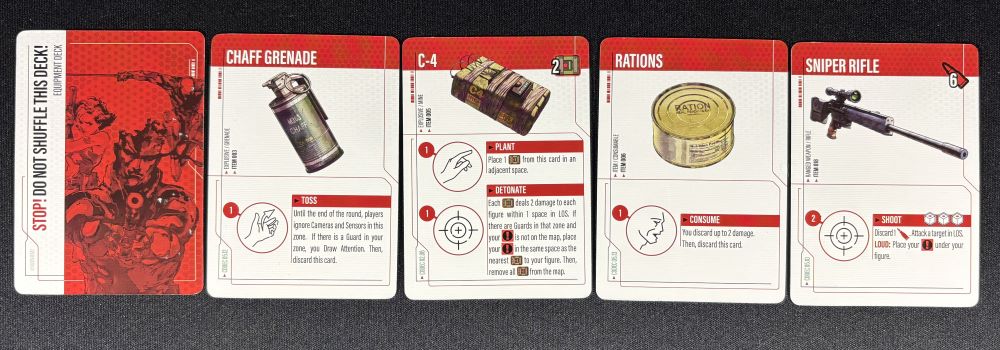
The player’s characters can use equipment. Some characters have starting equipment available to them while you can also unlock new equipment by completing the stages and VR missions. (You can also unlock one piece of equipment just by reading the back of the gamebox!)
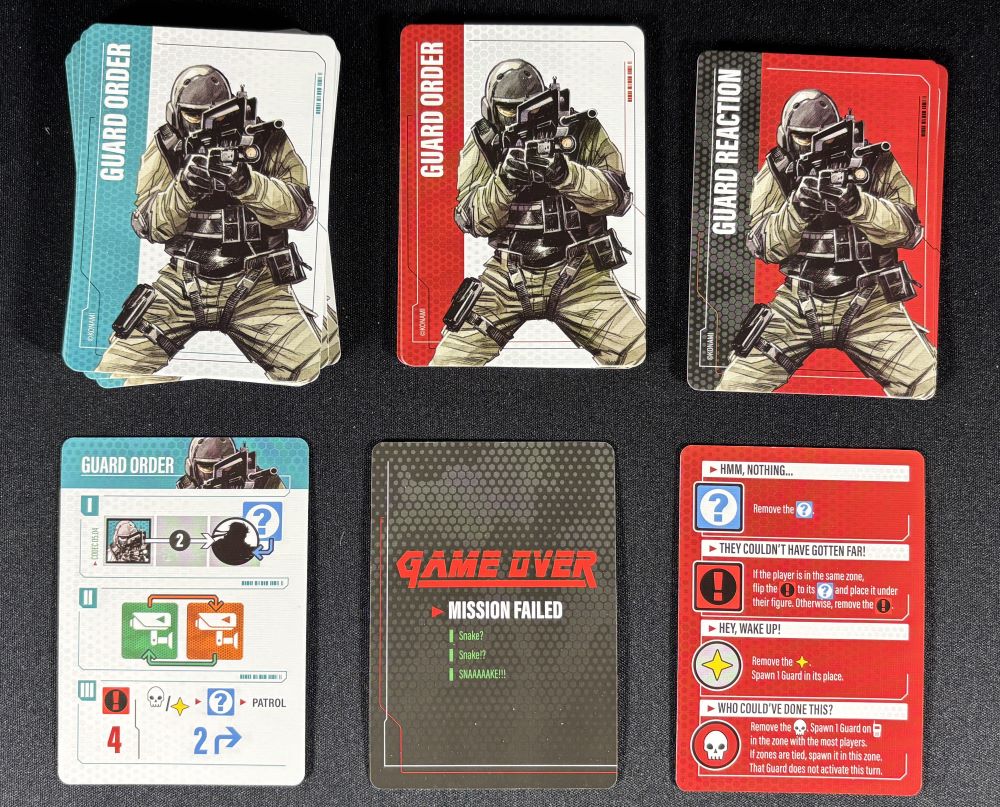
The guards are controlled by the Guard order and reaction cards. Each stage will let you know how many order cards to use. The red cards are placed beneath the blue order cards. One of them is a game over card, so once you get to the red cards, you don’t know exactly when the mission will end, but that it is close. How these cards are used is explained in the gameplay section of this article.
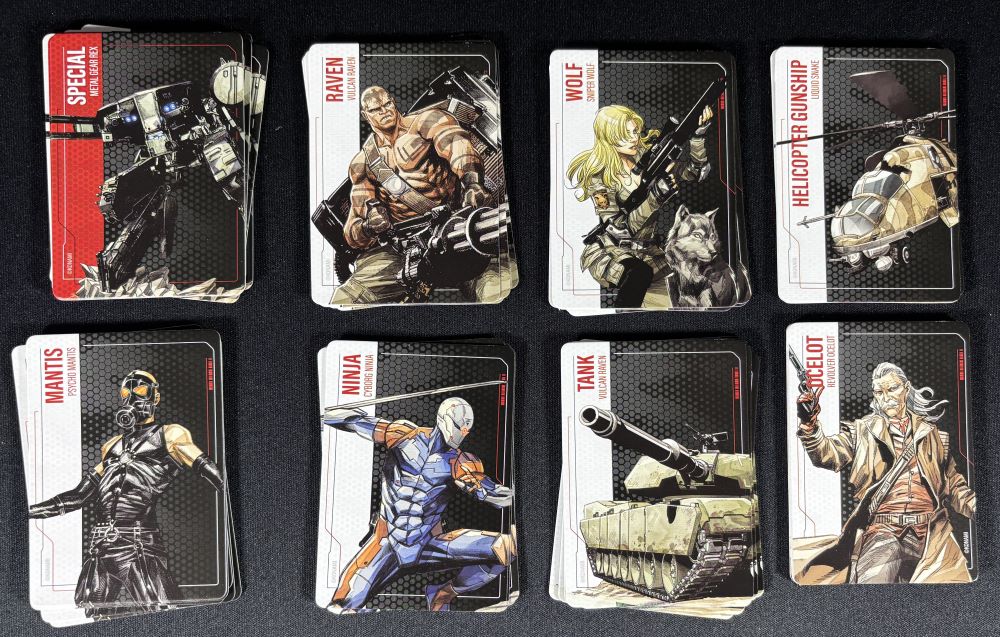
Just like the guards, each boss as their own deck of cards which describe the actions they take during their phase as well as how they react to your characters.
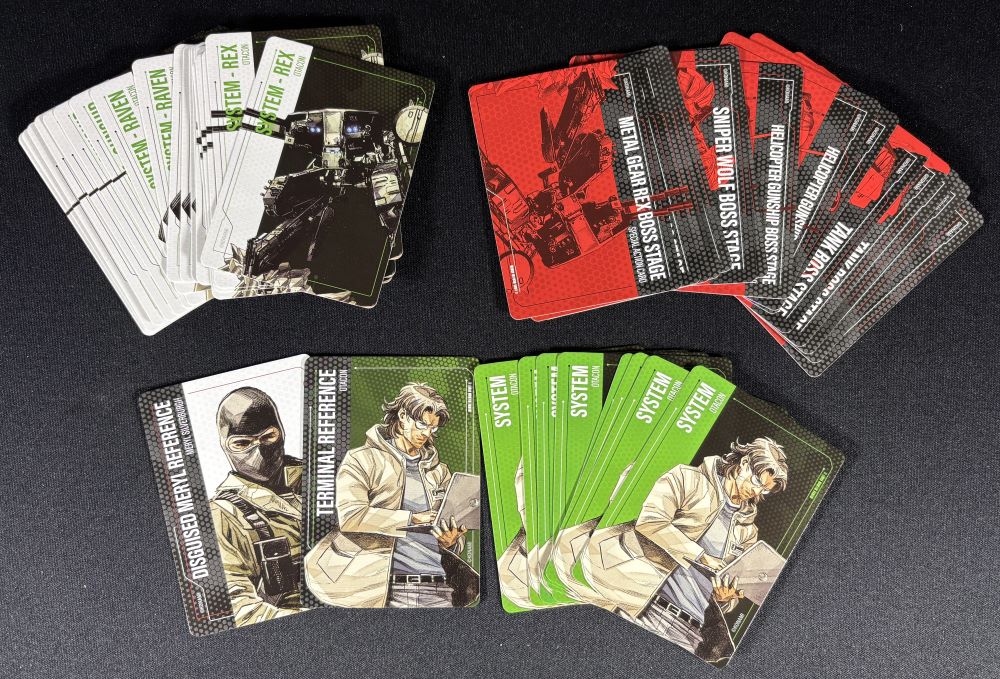
There are also a variety of other cards including Otacon boss system cards, Otacon system cards, Boss stage reference cards, and reference cards for Meryl’s disguise as well as for hacking terminals.
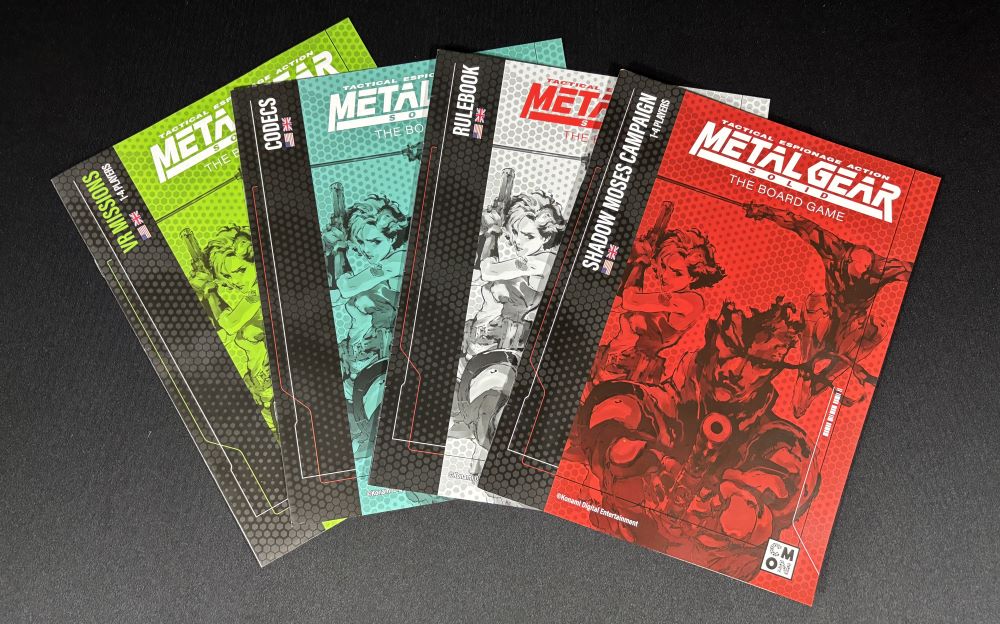
Metal Gear Solid: The Board Game comes with four different books. The rulebook contains all the instructions for playing the game and serves as a reference. The campaign book has instructions for setting up and playing all 14 stages of the campaign. In fact, for new players, you can get right into the game and play the first few stages without reading the rulebook. The campaign book teaches what you need to know and the first two stages serve as a tutorial. The VR missions book contains six stand-alone missions that are playable by 1-4 players. These are great ways to practice sneaking and once you clear each VR mission, you are awarded with new equipment you can add to your memory box. Finally, the Codecs book has text related to the codec text you may find on dashboards, equipment cards, boss dashboards and cards, and many other places. These codec texts help provide additional story information.
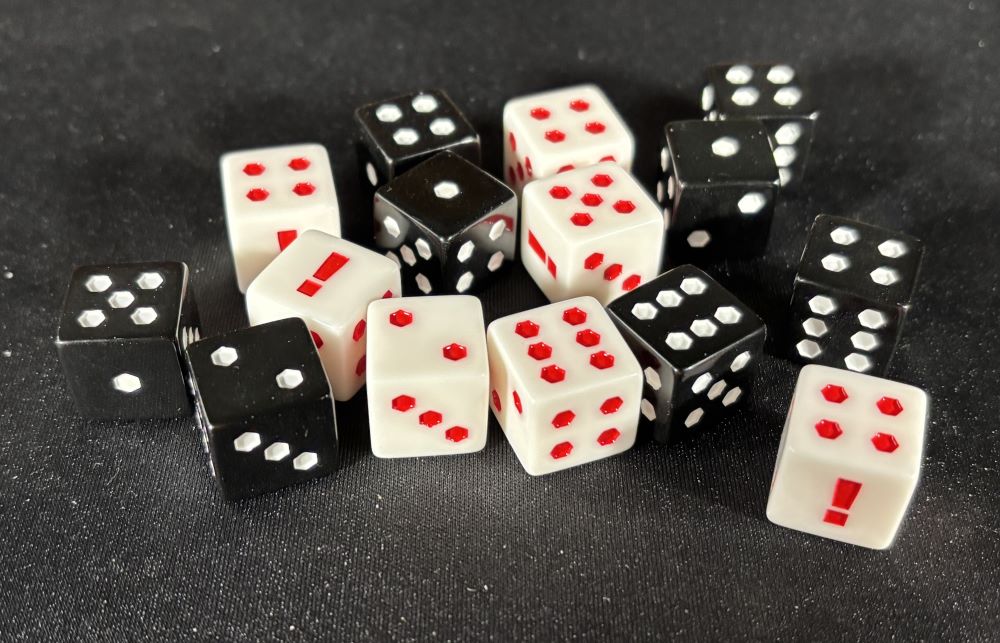
The game comes with 15 dice in both black and white The white dice have the one pip side replaced with a ‘!’. This is used when checking for noise. Also, the “!” does not count as a 1 when rolling, so when considering combat, it is considered a miss that can’t be modified by a +1 or +2 affect.
How to Play Metal Gear Solid: The Board Game
You can download a copy of the rulebook here.
The Goal
The goal of the game is to complete the objectives for a stage of the game. Some stages have optional objectives which can provide additioanls rewards if the players complete them.
Setup
Setting up a game is fairly straightforward. Each stage has setup directions in the campaign or VR missions books. For this explanation, the setup and gameplay for a sneaking stage is provided. Boss stages are similar but have a few minor differences. Start off by positioning the map tiles as shown in the directions, placing character and enemy figures and tokens as shown. Next setup the player area. After players select which characters they will play as, they place their respective player dashboard in front of them and collect their 4 action tokens, 4 focus tokens, and their character attention token. They then take any starting equipment for their character and any memory box equipment that has been acquired in previous missions. Damage as well as KO’d and Dead guard tokens are placed near the map tiles. Finally, setup the guard dashboard by placing it near the map. Follow the directions in the setup for how many blue and red guard order cards to place above the dashboard along with the guard reaction cards. You are now ready to play.
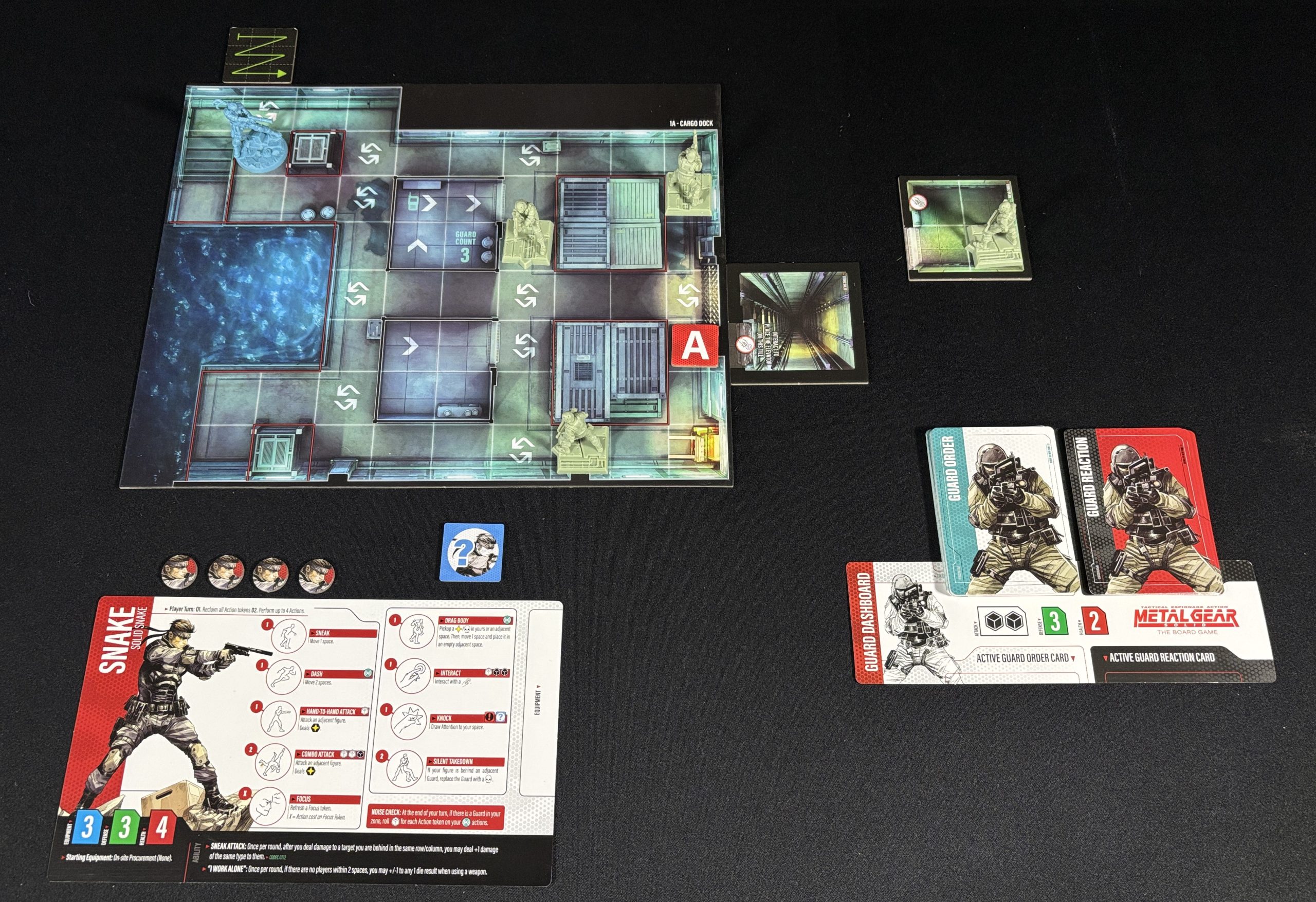
Gameplay
Player Phase
Metal Gear Solid: The Board Game is played in rounds. Each round is divided into a player phase and the enemy phase. During the player phase, the players take turns performing actions. They can take their turns in any order, but one player must complete all their actions before the next player goes. To perform an action, players take their action tokens and place them on actions on their player dashboard. Most actions cost one token but some cost two. The same action can be taken more than once, but the cost must be paid each time. For example, a player could use the sneak action four times to move four spaces. (All movement is orthogonal and never diagonal). At the end of their actions, if the player performed any action that has a Noisy icon next to it, they must perform a noise check by rolling one white die for each noisy action. If any of the dice rolled have an ‘!’ on it, then place the characters attention token underneath the player with the blue side up. This means someone heard you.
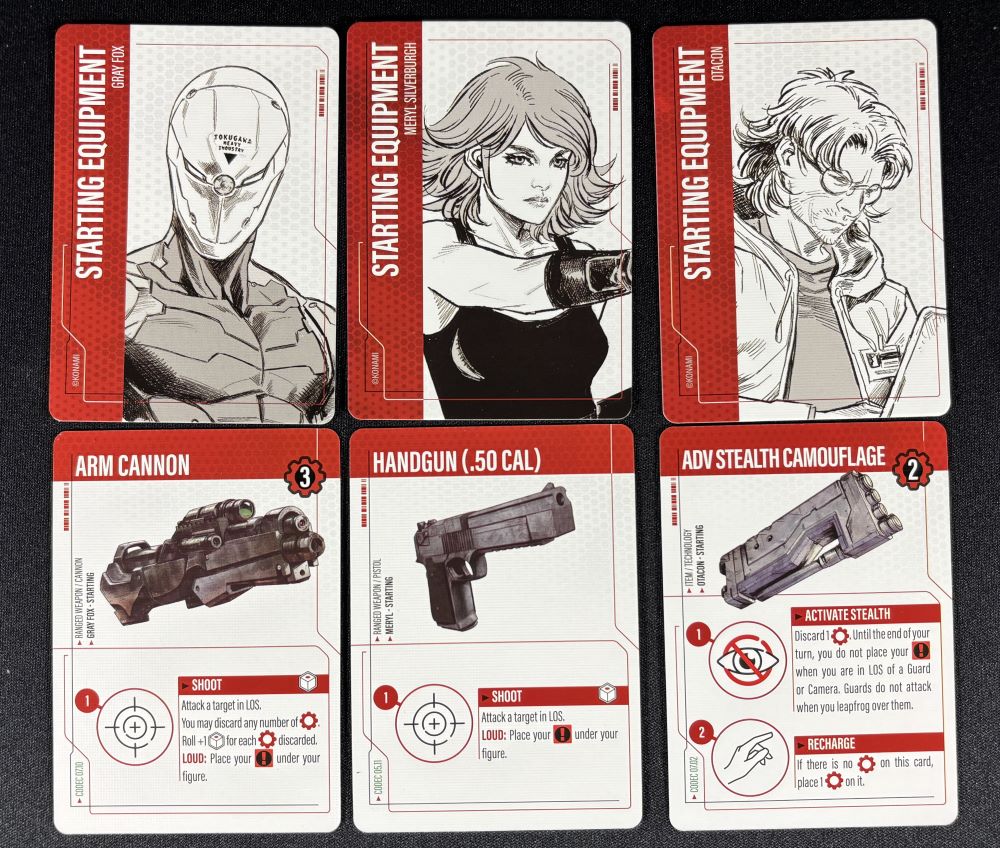
Enemy Phase
Once all players have completed their turns, it is now the enemy phase. Draw the top card from the guard order deck. It is divided into three parts. Resolve the card starting at the top and working your way down. The top has an affect for the area. The second part controls any cameras on the map. The bottom area directs how individual guards move depending on whether the guard is in alert, investigate, or patrol mode. Many of the stages require the players to use stealth to achieve their objectives. They want to move around without the enemy knowing they are there because once they guards are on alert, they are all coming for you. Let’s take a look at the three guard modes.
During patrol mode, guards move the number of spaces shown in blue on the guard order card. If they come to a wall, they turn in the direction there is a pathway. If they can turn left of right, they follow the arrow on the card. If they are at a dead end, they turn around and walk in the opposite direction. At the end of their movement, they face in the direction they will move the next round. Finally, if they end their movement on a space with two arrows, they turn in the direction of the arrow on the card, even if they are not at a wall. When moving guards, always start at the top left space of a zone and then move guards in order from left to right across a row of spaces, then going down to the next row, left to right, and so forth. It is important to follow this order since guards towards the bottom of the map may cause an alert, but it will not affect those near the top until their next round since they have already moved for that round.
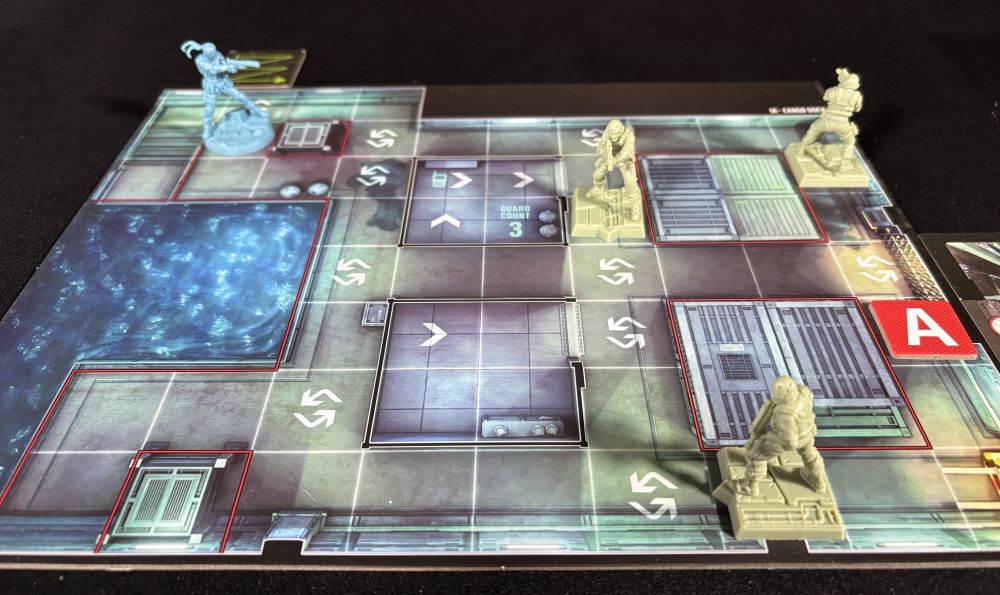
If a player has made a noise and places an attention token on the board, the nearest guard will move along the shortest route to investigate it. They also move towards any KO’d or Dead guard tokens in their LOS (Line Of Sight). Once they move onto any of these tokens, they draw a guard reaction card and resolve it depending on what type of token they are standing on. Since players can move off of an attention token on a subsequent turn, by the time a guard arrives, the player’s character may be gone. If a guard ever moves so that a player is in their LOS, they immediately attack. Also whenever a player is in the LOS of a guard, place the red alert side of the attention token under the character.
If an alert token is anywhere in the active zone, all guards are on alert. When they move, the all move towards the closest alert token following the shortest path. Once a guard reaches the space of an alert token, draw a guard reaction card and resolve it. Usually if there are no characters in sight of any guards, the token is returned to that player and if no other alert tokens are in the zone, the alert is called off and guards continue their patrol movement.
Line Of Sight
Metal Gear Solid: The Board Game features a unique method for determining LOS. First it is important to note that all guards have an arrow on their figure that points in the direction they are looking. LOS requires two conditions. First check to see if the guard is facing either the row or column the player’s figure is in. If so, then draw an imaginary box that includes both the guard and the player. If there are any obstacles such as walls, locked doors, or objects with red lines around them, anywhere in the box, then there is no LOS. Otherwise, the guard can see the player. Cameras work similarly and the direction they face is determined by the camera token. Guards do not have LOS to players behind them or directly on their left or right flank. As guards move, check for LOS if there are player figures nearby.
Combat
Combat is also fairly straightforward in the game. If you have LOS, then you can attack with ranged weapons. The guards all carry rifles and they only attack in this manner. The players have close combat attacks that require the player to be orthogonally adjacent to an enemy to attack. To resolve an attack, roll the number and type of dice listed for the attack. Guards always attack with two black dice. Players may attack with white and/or black dice depending on the type of attack. Weapons on equipment cards also have a space for an action token listed with the appropriate dice to roll. Each die represents a chance of getting a hit. You never add them together. Instead, compare the results of each die with the target’s defense value. If the roll is equal to or greater than the defense, then one damage is inflicted on the target. Place a damage token on the player dashboard if the player was the target or next to the guard figure. If a player or enemy ever receives damage equal to or greater than their health, they are Killed in Action. When a guard is KIA, place a skull token on its space and remove the figure. Players may try to knock out guards with close combat attacks. Instead of a damage token, give them a KO’d token. If they receive KO’d damage equal to their health, remove their figure and replace it with a KO guard token with side with two stars face up.
Game End
The game ends when the players have completed their objectives or if any player is ever KIA or another failure condition has been met.
Metal Gear Solid: The Board Game is GeekDad Approved!
Why You Should Play Metal Gear Solid: The Board Game
As I mentioned earlier, I was a excited to play Metal Gear Solid: The Board Game. However, I was also a bit apprehensive. Would the designer be able to create a fun game that was true to the original feel and theme. I have enjoyed games by the designer, Emerson Matsuuchi such as the Century series (Century: Spice Road, Century: Eastern Wonders, and Century: A New World) as well as HerStory. I have also been impressed by CMON’s games. Yet a stealth cooperative game? The miniature figures are very detailed as one would expect from CMON as is the presentation including the organizer to keep all of the components–organized. On the topic of components, they are all great. I really like the artwork on the cards, dashboards, map tiles, and even withing the rulebook and other books.
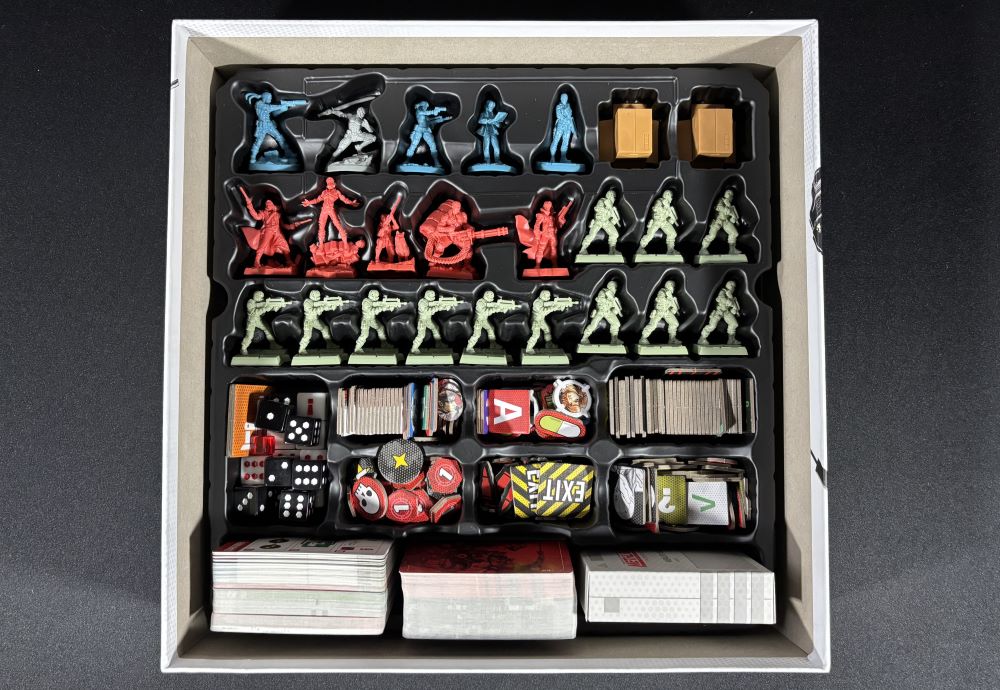
While the rulebook is not that large, I really appreciated that the first paragraph in the rulebook told me to go to the campaign book to play the first two stages and then come back. Just like many video games will provide a few easy missions that teach you the game as you go, Metal Gear Solid: The Board Game also features something like a tutorial that walks you through the main rules over the course of two games. This gets players right into the campaign. Though the first two stages are only for one player, this provides the basics a player can use to teach others. Most of the stages can be played by two players and the final five stages can be played by up to four players. I actually like playing solo and controlling two or more characters so I can use their abilities together. However, when playing with a group, the VR missions are a great way to play and introduce new layers to the game. These are all stand-alone missions that focus on stealth. They can all be played with 1-4 players and the objectives become more difficult as you add more players. For an additional challenge, you can even swap out one of the guards with any of the boss characters. Not only do you unlock equipment for each VR mission you complete, you also unlock more equipment by defeating the bosses. The combination of the campaign and the VR missions provides not only hours of gameplay, but also different ways to play.
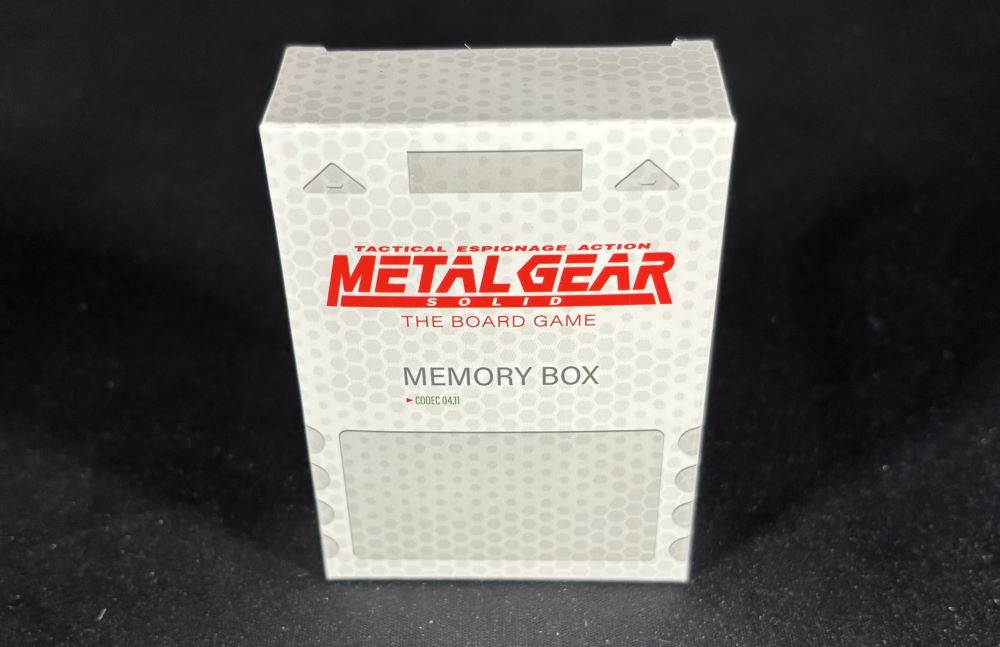
Cooperative and solo games require a system for controlling non-player characters and Metal Gear Solid: The Board Game has one of the most user-friendly systems for doing this. The guard order and reaction cards provide some variety in the ways the guards patrol as well as interact with the environment. They guards don’t always move the same distance each round and they may turn different directions when they come to an intersection. Plus the double arrows marked on the maps provides another level of randomness. If a guard happens to stop on one of these, they will turn either right or left instead of continuing straight. This keeps players on their toes and several times my perfect plans were disrupted by a guard making a random turn and coming down a hallway towards me. The guard cards also let you know when to spawn more guards and control which direction the cameras are facing. Unlike guards, cameras are always on and moving into their LOS causes an automatic alert. I am very impressed with the rules that control the enemies so they don’t take up a lot of the player’s time with complexity.
Another area where simplicity is a plus is LOS. In most games with miniatures, there are rules to determine if you can see the enemy and if they can see you. For many games I have played, this has been quite complex and I find myself frequently referring to the rules. Metal Gear Solid: The Board Game makes LOS extremely easy. I already described how LOS is determined. In reading online questions by players, I found that many were overthinking this concept. They were trying to bring in rules from other games they have played. I too found myself with the same issues at first. However, when I went back to the rules and read them as they are–without adding my own interpretation–I found them very refreshing. From that point on, I had no trouble with LOS and after a few games, it becomes second nature. Along those same lines, combat also benefits from simplicity. There are no modifiers to combat for cover or anything. If you can see the target, you can shoot at it. While some games benefit from more complex rules, the rules in this game let players focus on playing the game and experience the tension of trying to infiltrate a heavily secure facility without being killed.
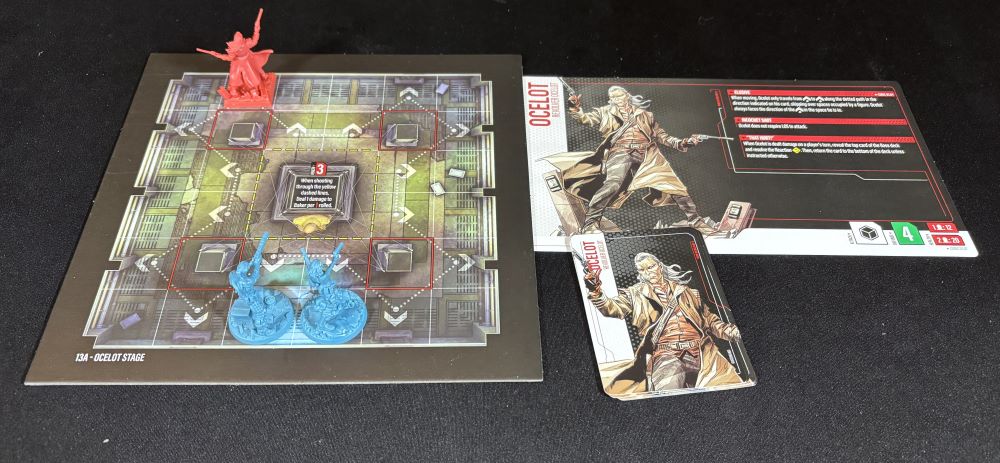
The more I play Metal Gear Solid: The Board Game, the more I like the game. In some ways the sneaking stages are like puzzles. However, there is no set solution because the patrols of the guards are always different. In addition, there are some cool ways to trick the guards. Players can use the knock action to place an attention token in their space and then move away. This can lure a guard away from their patrol and create an opening. Furthermore, the game is not easy. I played the first stage 3-4 times before I beat it. It also took me a few times to beat the second stage. I barely beat the first boss stage on the first try. This game works great for solo play. It also is a lot of fun with 2 to 4 players since you all have to work together. If one player triggers an alert, the guards all start coming at you. Though this can also allow other players to access areas formerly covered by guards before they moved towards the alert. In conclusion, I highly recommend Metal Gear Solid: The Board Game. For all the many reasons I have mentioned, this game deserves to be GeekDad Approved! I continue to enjoy playing it and introducing it to new people. If you like solo and cooperative games where the game is the challenge and not the rules, then be sure to add Metal Gear Solid: The Board Game to your game collection.
For more information, visit the Metal Gear Solid: The Board Game page!
Click here to see all our tabletop game reviews.
![]() To subscribe to GeekDad’s tabletop gaming coverage, please copy this link and add it to your RSS reader.
To subscribe to GeekDad’s tabletop gaming coverage, please copy this link and add it to your RSS reader.
Disclosure: GeekDad received a copy of this game for review purposes.
